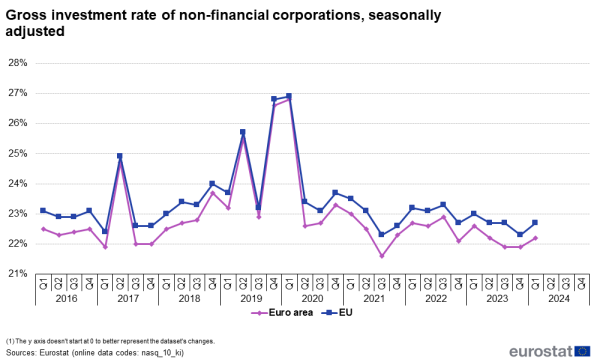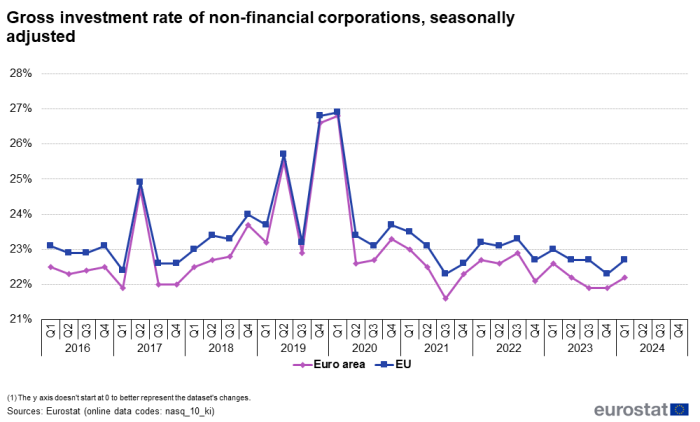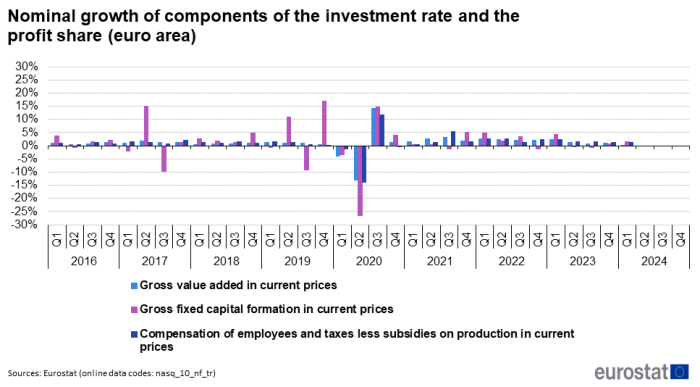Quarterly sector accounts - non-financial corporations
Data extracted on 25 July 2024.
Planned article update: 29 October 2024.
Highlights
In the first quarter of 2024, business investment rate went up to 22.2 % in the euro area and up to 22.7 % in the EU.
In the first quarter of 2024, business profit share went down to 39.5 % in the euro area and down to 39.9 % in the EU.

Source: Eurostat (nasq_10_ki)
This article focuses on a selection of indicators from the quarterly sector accounts for non-financial corporations in the European Union (EU) and the euro area. Covered are, among others, the business investment rate and the profit share of non-financial corporations. A similar article focuses on quarterly sector accounts for households, covering, among others, the household saving rate and the household investment rate.
Full article
Business investment rate up in the euro area and in the EU
The business investment rate in the euro area (EA-20) increased to 22.2 % from 21.9 % in the previous quarter. In the EU, the investment rate went up, reaching 22.7 % in the first quarter of 2024, compared with 22.3 % in the previous quarter. The peaks in 2015Q2, 2017Q2, 2019Q2, 2019Q4 and 2020Q1 can be attributed to imports of intellectual property products reflecting the impact of globalisation.
These data come from a detailed set of seasonally adjusted[1] quarterly European sector accounts released by Eurostat, the statistical office of the European Union and the European Central Bank (ECB).

Source: Eurostat (nasq_10_ki)
Declining business profit in the euro area and the EU
The business profit share dropped in both the euro area and the EU during the first quarter of 2024. In the euro area, the profit share dropped from 40.2 % to 39.5 %, while in the EU, it decreased from 40.7 % to 39.9 %.

Source: Eurostat (nasq_10_ki)
The decline in profit share within the euro area can be attributed to a modest increase in business gross value added (+0.2 %), while compensation of employees (wages and social contributions) plus taxes less subsidies on production saw a higher rise of 1.4 %. On the other hand, investment (gross fixed capital formation) showed an increase of 1.7 % in the euro area, explaining the overall increase in business investment rate.

Source: Eurostat (nasq_10_nf_tr)
Data sources
The compilation of the European sector accounts follows the European System of Accounts 2010 (ESA 2010) and covers the period from the first quarter of 1999 onwards.
Following recommendations for a harmonised European revision policy for national accounts and balance of payments, EU countries will carry out a benchmark revision of their national accounts estimates in 2024. The purpose of this benchmark revision is to implement changes introduced by the amended ESA 2010 regulation, and to incorporate new data sources and other methodological improvements. Most of the revised quarterly and annual country data are expected to be released by Eurostat between June and October 2024, and will be progressively integrated in European estimates. The impact of these revisions is expected to be limited, but still noticeable for some European aggregates and more pronounced for certain Member States. For further details, please consult the available documentation on Eurostat’s website. The European estimates published today include benchmark revisions from Czechia, Denmark, France, Ireland, the Netherlands and Sweden.
Institutional sectors bring together economic units with broadly similar characteristics and behaviour, namely: households (including non-profit institutions serving households), non-financial corporations, financial corporations, government and the rest of the world. In the latter, to measure the external transactions of the euro area / EU, it is necessary to remove cross-border flows within the area concerned.
The ECB and Eurostat publish integrated non-financial and financial accounts, including financial balance sheets, for the euro area. Eurostat also publishes the non-financial and financial accounts of the European Union.
Eurostat's dataset includes detailed annual sector accounts by country and derived key indicators, which also include the indicators that combine non-financial and financial accounts, such as debt-to-income ratios.
Eurostat's dataset includes detailed Sequence of accounts and derived key indicators, which also include the indicators that combine non-financial and financial accounts such as debt-to-income ratios.
The full set of quarterly sector accounts is published for euro area / EU aggregates. Quarterly sector accounts data are also available for most of the European Economic Area (EEA) Member States in the Eurostat database and a subset of quarterly key indicators is published around 102 days after each quarter at quarterly data and annual data. The EEA members whose GDP is below 1 % of the EU total do not have to transmit the quarterly accounts of households to Eurostat.
General information on European sector accounts compilation is given in the metadata file.
For detailed data and methodology, please see Eurostat's website and ECB's website.
- The European Union (EU) consists of 27 Member States: Belgium, Bulgaria, Czechia, Denmark, Germany, Estonia, Ireland, Greece, Spain, France, Croatia, Italy, Cyprus, Latvia, Lithuania, Luxembourg, Hungary, Malta, the Netherlands, Austria, Poland, Portugal, Romania, Slovenia, Slovakia, Finland and Sweden plus the EU institutions.
- The euro area (EA-20) consists of 20 Member States: Belgium, Germany, Estonia, Ireland, Greece, Spain, France, Croatia, Italy, Cyprus, Latvia, Lithuania, Luxembourg, Malta, the Netherlands, Austria, Portugal, Slovenia, Slovakia and Finland, plus the European Central Bank, the European Stability Mechanism and the European Financial Stability Facility. From 1 January 2023, the euro area (EA-20) also includes Croatia. The aggregate data series presented in this article refer to EA-20.
Source data for tables and graphs
The detailed tables ![]() are available here.
are available here.
Direct access to
Notes
- ↑ Seasonal adjustment has been performed using the Tramo-Seats method. The seasonally adjusted series are built up indirectly as the sum of seasonally adjusted components.